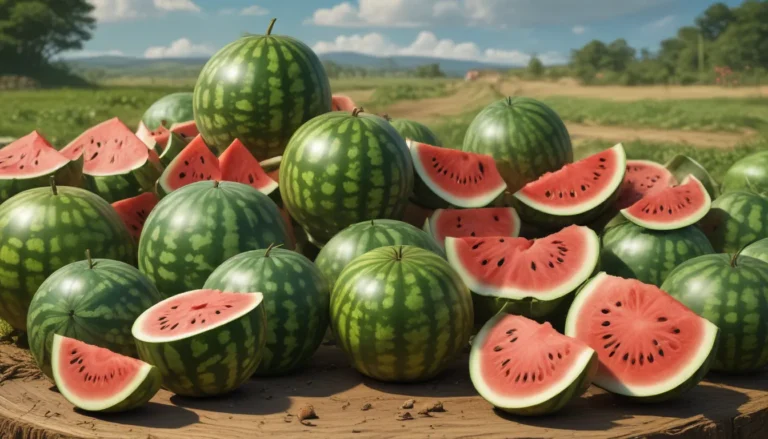A Comprehensive Guide to Planting and Growing Brandywine Tomatoes

If you are anything like me, the anticipation of waiting for those tomatoes to ripen in the summer is almost unbearable. But when it comes to that first bite of a freshly sliced ‘Brandywine,’ all the waiting is absolutely worth it.
Known for its juicy and flavorful large fruit, the ‘Brandywine’ tomato is a favorite among many gardeners. Whether you enjoy it on a sandwich or in a crisp summer salad, this heirloom cultivar never disappoints.
But growing these delicious tomatoes takes a bit of know-how. In this guide, we will cover everything you need to know about planting and growing ‘Brandywine’ tomatoes in your garden.
What You’ll Learn
- What Are ‘Brandywine’ Tomatoes?
- Cultivation and History
- Propagation
- How to Grow
- Growing Tips
- Pruning and Maintenance
- Where to Buy
- Managing Pests and Disease
- Harvesting
- Preserving
- Recipes and Cooking Ideas
- Quick Reference Growing Guide
What Are ‘Brandywine’ Tomatoes?
‘Brandywine’ tomatoes are a beloved heirloom cultivar that thrives in USDA Zones 3 through 9. Known for its large, beefsteak-like fruits that come in red, pink, or yellow, these tomatoes are a popular choice for slicing and enjoying fresh.
The plants are characterized by tall vines that can reach up to nine feet when properly trained and unique foliage with smooth, oval leaves akin to those of a potato plant. ‘Brandywine’ tomatoes take around 80 to 100 days to produce fruit, but their indeterminate growth habit means they will continue to bloom and bear fruit as long as conditions are right.
Cultivation and History
With a history dating back over a century, ‘Brandywine’ tomatoes are considered one of the oldest heirloom varieties commercially available. While their origins are often linked to the Amish community, the exact history remains unclear.
One story traces back to an Ohio gardener named Ben Quisenberry, who received seeds of the true ‘Brandywine’ variety from Dorris Sudduth Hill in Pennsylvania. These seeds had been in her family for over 80 years. ‘Brandywine’ seeds were listed in seed catalogs by companies such as Burpee and Johnson and Stokes in the late 1800s, though the exact lineage of these seeds remains a mystery.
Over the years, various substrains of ‘Brandywine’ tomatoes have developed, resulting in numerous cultivars with similar names. While the exact origins may be debated, ‘Brandywine’ tomatoes have secured their place as a beloved homegrown favorite.
Propagation
To grow ‘Brandywine’ tomatoes, it’s best to start indoors a couple of months before the last frost. Plant the seeds a quarter inch deep in well-draining soil and maintain a warm temperature between 65 and 90°F for optimal germination.
Once the seedlings sprout, provide ample light and gradually acclimate them to outdoor conditions before planting them in the garden. ‘Brandywine’ tomatoes are frost-sensitive, so wait until all threats of frost have passed before planting them in the garden.
How to Grow
Growing ‘Brandywine’ tomatoes requires full sun, well-draining soil with ample organic matter, and regular watering. Mulching, proper spacing, and occasional fertilization are essential for healthy plant growth.
- Growing Tips:
- Plant in full sun.
- Provide well-draining soil high in organic matter.
- Maintain 24-36 inches of space between plants.
- Avoid planting near nightshades.
- Apply mulch to regulate soil temperature and reduce weeds.
Pruning and Maintenance
Due to their vigorous growth, ‘Brandywine’ tomatoes benefit from pruning and support. Use cages or trellises to support the plants and remove suckers to improve airflow and fruit production.
Additionally, trim any foliage touching the ground to reduce the risk of diseases such as blight.
Where to Buy
You can find ‘Brandywine’ tomato seeds in various colors from reputable seed catalogs. Consider options like True Leaf Market or Eden Brothers for a wide range of colors and varieties.
Managing Pests and Disease
‘Brandywine’ tomatoes are susceptible to common tomato pests and diseases, including fungal infections, molds, and pests like hornworms, loopers, and aphids. Proper crop rotation, spacing, and watering practices can help minimize disease risks.
Consider companion planting with marigolds or herbs for natural pest repellents.
Harvesting
‘Brandywine’ tomatoes are ripe when they reach their designated color and can be gently twisted off the vine once mature. Regular harvesting is key to preventing split fruits and ensuring optimal taste.
Preserving
With a relatively short shelf life, consider preserving ‘Brandywine’ tomatoes through freezing, canning, or drying methods. These preserved tomatoes retain their flavor and can be used in various dishes.
Recipes and Cooking Ideas
Fresh ‘Brandywine’ tomatoes are perfect for sandwiches, salads, sauces, and more. Experiment with recipes like pizzas, flatbreads, bruschettas, and pasta salads to showcase the rich flavor of these heirloom tomatoes.
Quick Reference Growing Guide
Refer to this quick guide for essential information on planting and growing ‘Brandywine’ tomatoes in your garden.
A Little Slice of Summer
Growing ‘Brandywine’ tomatoes is a rewarding experience that yields delicious fruits perfect for summer dishes. Share your tips and experiences with growing ‘Brandywine’ tomatoes in the comments below.
For more gardening tips and information on growing flavorful tomatoes, be sure to explore our additional articles on tomato cultivation and care.





